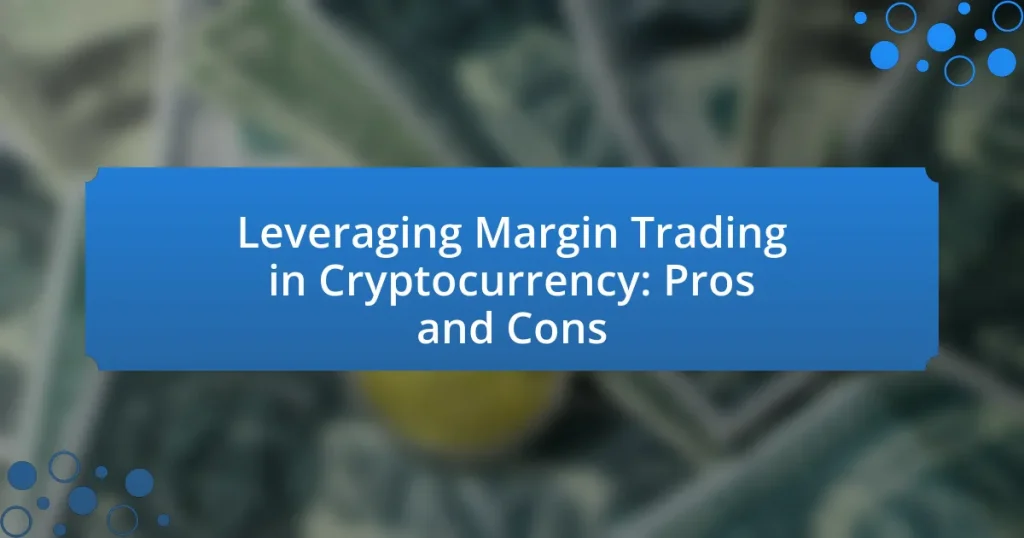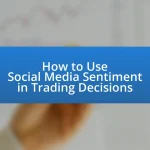Margin trading in cryptocurrency is a strategy that allows traders to borrow funds to increase their trading positions, thereby amplifying potential returns while also heightening the risk of significant losses. This article explores the mechanics of margin trading, including key components such as leverage, margin requirements, and liquidation risks. It discusses various types of margin trading, including traditional, cross, and isolated margin trading, and examines the advantages and disadvantages of leveraging margin trading, such as increased market exposure and the potential for liquidation. Additionally, it highlights best practices for effective margin trading, including risk management strategies and common pitfalls to avoid, providing a comprehensive overview for traders looking to navigate this high-risk trading method.
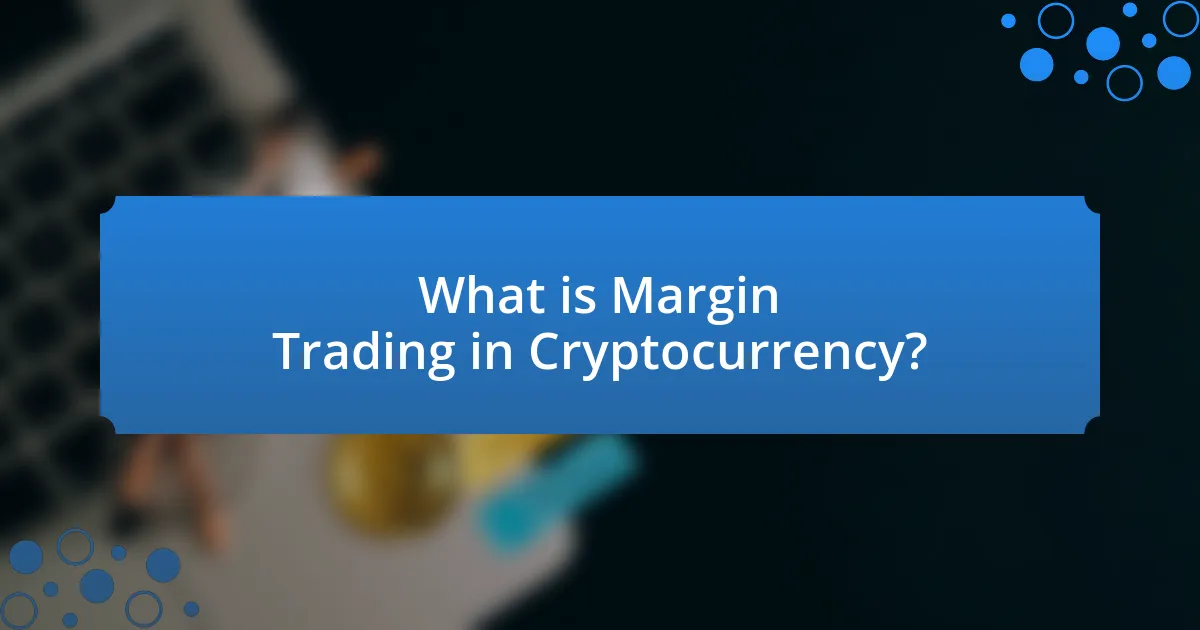
What is Margin Trading in Cryptocurrency?
Margin trading in cryptocurrency is a method that allows traders to borrow funds to increase their trading position beyond what they could achieve with their own capital. This practice enables traders to amplify potential returns, but it also increases the risk of significant losses. For instance, if a trader uses 2x leverage, they can control a position worth twice their initial investment, but if the market moves against them, losses can exceed their initial capital. This mechanism is commonly facilitated by exchanges that offer margin accounts, where traders can access borrowed funds based on their collateral.
How does Margin Trading function in the cryptocurrency market?
Margin trading in the cryptocurrency market allows traders to borrow funds to increase their position size, enabling them to trade larger amounts than their actual capital. This process involves a trader depositing a certain amount of their own capital, known as margin, which acts as collateral for the borrowed funds. For example, if a trader wants to buy $10,000 worth of Bitcoin but only has $1,000, they can use margin trading to borrow the remaining $9,000 from a broker or exchange.
When the trade is executed, the potential for profit increases, but so does the risk of loss. If the market moves against the trader’s position, they may face a margin call, requiring them to deposit more funds to maintain their position or risk liquidation of their assets. According to a report by the Financial Industry Regulatory Authority (FINRA), margin trading can amplify both gains and losses, making it a high-risk strategy. Thus, understanding the mechanics and risks of margin trading is crucial for participants in the cryptocurrency market.
What are the key components of Margin Trading?
The key components of margin trading include leverage, margin requirement, and liquidation. Leverage allows traders to control a larger position with a smaller amount of capital, amplifying both potential gains and losses. The margin requirement is the minimum amount of equity a trader must maintain in their account to open and sustain a leveraged position, typically expressed as a percentage of the total trade value. Liquidation occurs when a trader’s equity falls below the required margin level, resulting in the automatic closure of positions to prevent further losses. These components are essential for understanding the risks and mechanics involved in margin trading.
How do leverage and margin requirements work?
Leverage allows traders to control a larger position with a smaller amount of capital by borrowing funds, while margin requirements refer to the minimum amount of equity a trader must maintain in their account to open and maintain leveraged positions. For example, if a trader uses 10x leverage, they can control $10,000 worth of assets with only $1,000 of their own capital, but they must meet the margin requirement set by the exchange, which is typically a percentage of the total position size. This means that if the value of the assets declines, the trader risks a margin call, requiring them to deposit more funds or close positions to maintain the required equity level.
What are the different types of Margin Trading?
The different types of margin trading include traditional margin trading, cross margin trading, and isolated margin trading. Traditional margin trading allows traders to borrow funds to increase their position size, while cross margin trading uses the total balance of a trader’s account to cover margin requirements across multiple positions, reducing the risk of liquidation. Isolated margin trading, on the other hand, limits the margin used for a specific position, protecting the rest of the account from potential losses. Each type serves distinct trading strategies and risk management approaches in the cryptocurrency market.
What is cross margin trading?
Cross margin trading is a method where a trader uses the total balance of their margin account to cover potential losses across multiple positions. This approach allows for greater flexibility and risk management, as it pools available funds to maintain margin requirements for all open trades. In cross margin trading, if one position incurs a loss, the margin from other profitable positions can be utilized to prevent liquidation, thereby reducing the risk of losing the entire account balance. This method is particularly beneficial in volatile markets, such as cryptocurrency, where price fluctuations can be significant.
What is isolated margin trading?
Isolated margin trading is a method where a trader allocates a specific amount of funds to a single position, limiting the risk to only that amount. This approach contrasts with cross margin trading, where all available funds in the account can be used to cover losses across multiple positions. In isolated margin trading, if the position incurs losses, only the allocated margin is at risk, protecting the trader’s other funds from being affected. This strategy is particularly useful for managing risk in volatile markets, as it allows traders to control their exposure on a per-trade basis.
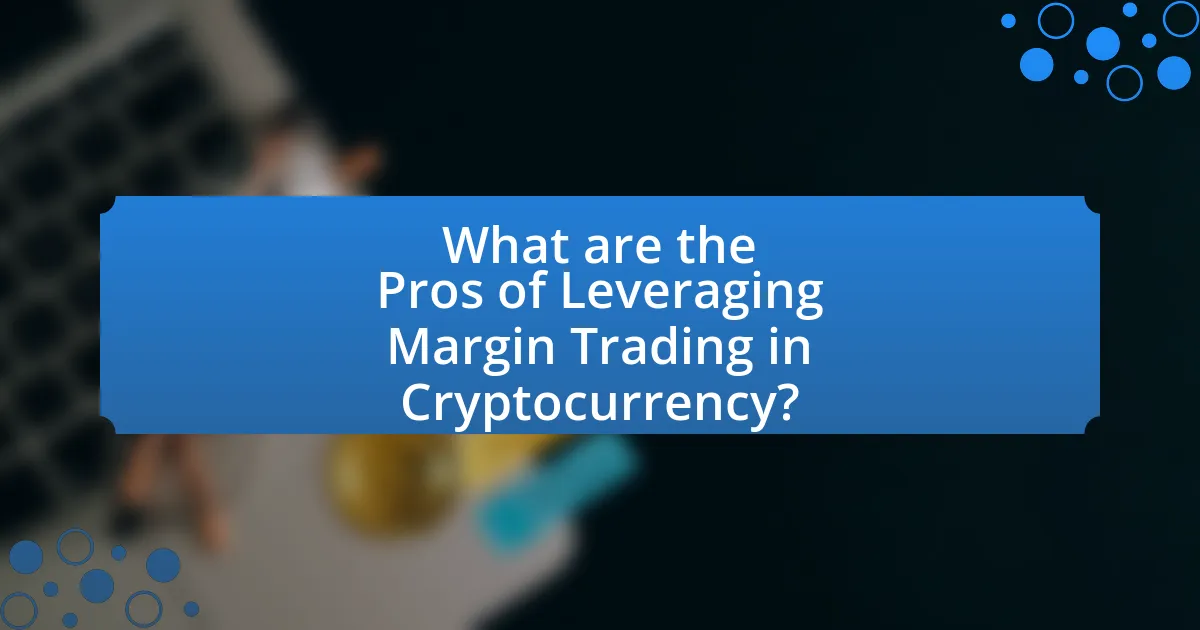
What are the Pros of Leveraging Margin Trading in Cryptocurrency?
Leveraging margin trading in cryptocurrency allows traders to amplify their potential profits by borrowing funds to increase their position size. This strategy can lead to significantly higher returns on investment, as traders can control larger amounts of cryptocurrency than they could with their own capital alone. For example, with a 2x leverage, a trader can double their exposure, meaning that a 10% increase in the asset’s price results in a 20% profit on their initial investment. Additionally, margin trading can enhance liquidity in the market, as it encourages more trading activity and can lead to tighter spreads. Furthermore, it provides opportunities for short selling, allowing traders to profit from declining markets.
How can Margin Trading amplify profits?
Margin trading amplifies profits by allowing traders to borrow funds to increase their position size, thereby magnifying potential returns on investment. For example, if a trader uses 2x leverage, a 10% increase in the asset’s price results in a 20% profit on their initial capital. This amplification occurs because the trader is effectively controlling a larger amount of capital than they own, which can lead to higher gains when the market moves in their favor. However, it is essential to note that while margin trading can enhance profits, it also increases the risk of significant losses if the market moves against the trader.
What role does leverage play in profit potential?
Leverage significantly enhances profit potential by allowing traders to control larger positions with a smaller amount of capital. In margin trading, for instance, a leverage ratio of 10:1 means that for every $1 of their own capital, traders can control $10 in the market. This amplification can lead to substantial gains if the market moves in their favor. According to a report by the Financial Industry Regulatory Authority (FINRA), using leverage can increase returns on investment, but it also increases risk, as losses can be magnified in the same manner. Thus, while leverage can boost profit potential, it also requires careful risk management to avoid significant losses.
How does Margin Trading allow for greater market exposure?
Margin trading allows for greater market exposure by enabling traders to borrow funds to increase their investment size beyond their actual capital. This leverage amplifies potential returns, as traders can control larger positions with a smaller amount of their own money. For instance, if a trader uses 10x leverage, they can trade $10,000 worth of assets with only $1,000 of their own capital. This mechanism increases the potential for profit, as even small price movements can lead to significant gains relative to the initial investment. However, it also increases risk, as losses can similarly be magnified, leading to the possibility of losing more than the initial investment.
What advantages does Margin Trading offer to traders?
Margin trading offers traders the advantage of increased buying power, allowing them to control larger positions than their actual capital would permit. This leverage can amplify potential profits, as traders can gain exposure to significant market movements with a smaller initial investment. For instance, with a 2:1 leverage, a trader can control $10,000 worth of assets with only $5,000 of their own capital, potentially doubling their returns if the market moves favorably. Additionally, margin trading can enhance trading strategies by enabling short selling, which allows traders to profit from declining markets.
How does it enhance trading strategies?
Margin trading enhances trading strategies by allowing traders to amplify their buying power, enabling them to control larger positions with a smaller amount of capital. This leverage can lead to increased potential profits, as traders can benefit from price movements in the market that would be unattainable with their own capital alone. For instance, if a trader uses 5x leverage, a 10% increase in the asset price results in a 50% profit on their initial investment. However, it is crucial to note that while margin trading can enhance profits, it also increases the risk of significant losses, as the same leverage can amplify losses if the market moves against the trader.
What are the benefits of short selling in Margin Trading?
Short selling in margin trading allows traders to profit from declining asset prices. This strategy enables investors to sell borrowed assets with the expectation of repurchasing them at a lower price, thus generating profit from the difference. Additionally, short selling can serve as a hedge against long positions, providing a way to mitigate potential losses in a volatile market. According to a study by the Financial Industry Regulatory Authority, short selling contributes to market efficiency by facilitating price discovery and liquidity, which can enhance overall market stability.
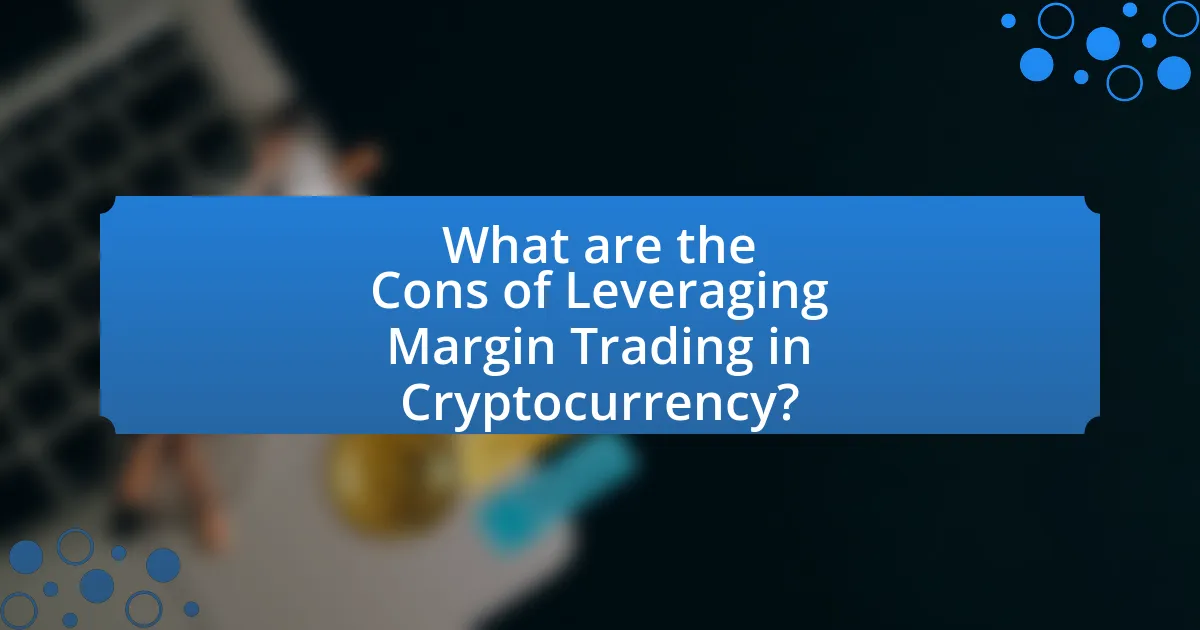
What are the Cons of Leveraging Margin Trading in Cryptocurrency?
The cons of leveraging margin trading in cryptocurrency include the potential for significant financial losses, increased risk of liquidation, and heightened emotional stress for traders. When traders use margin, they borrow funds to increase their position size, which amplifies both gains and losses. For instance, a 10% decline in the value of a cryptocurrency can lead to a total loss of the initial investment if the position is highly leveraged. Additionally, if the market moves against a trader’s position, they may face liquidation, where the exchange automatically closes their position to cover the borrowed funds, often resulting in substantial losses. Furthermore, the psychological pressure of managing leveraged positions can lead to impulsive decisions, exacerbating the risk of loss.
What risks are associated with Margin Trading?
Margin trading involves significant risks, including the potential for substantial financial losses. When traders use borrowed funds to amplify their positions, they can face margin calls if the market moves against them, requiring them to deposit additional funds or liquidate positions at a loss. According to a report by the Financial Industry Regulatory Authority (FINRA), approximately 25% of margin accounts experience a margin call during volatile market conditions, highlighting the inherent risk of leveraged trading. Additionally, the use of leverage can lead to losses exceeding the initial investment, as traders are responsible for repaying borrowed amounts regardless of their account balance.
How can losses be magnified through leverage?
Losses can be magnified through leverage because leverage allows traders to control a larger position than their actual capital, increasing both potential gains and potential losses. For instance, if a trader uses 10x leverage, a 10% decline in the asset’s price results in a 100% loss of the trader’s initial investment. This occurs because the trader is effectively borrowing funds to amplify their position, meaning that even small market movements can lead to significant financial repercussions. Historical data from margin trading in cryptocurrency markets shows that many traders have faced liquidation due to rapid price declines, illustrating the risks associated with high leverage.
What is the risk of liquidation in Margin Trading?
The risk of liquidation in margin trading occurs when the value of an investor’s collateral falls below a certain threshold, leading the broker to close positions to recover the loaned funds. This typically happens when the market moves against the trader’s position, resulting in losses that exceed the margin requirement. For example, if a trader uses 10x leverage and the asset price drops by 10%, the entire investment can be wiped out, triggering liquidation. According to a report by the Financial Industry Regulatory Authority (FINRA), high leverage increases the likelihood of liquidation, especially in volatile markets, making risk management crucial for traders.
How does market volatility impact Margin Trading risks?
Market volatility significantly increases the risks associated with margin trading. When market prices fluctuate dramatically, traders using margin face the potential for rapid losses that can exceed their initial investment. For instance, during periods of high volatility, such as the cryptocurrency market’s fluctuations in 2021, traders experienced liquidations of positions due to margin calls, where the value of collateral fell below required levels. This phenomenon illustrates that heightened volatility can lead to swift and substantial financial consequences for margin traders, emphasizing the need for careful risk management strategies.
What strategies can mitigate risks in volatile markets?
To mitigate risks in volatile markets, traders can employ strategies such as diversification, stop-loss orders, and position sizing. Diversification involves spreading investments across various assets to reduce exposure to any single asset’s volatility. For instance, a portfolio that includes a mix of cryptocurrencies, stocks, and bonds can buffer against sharp declines in one sector. Stop-loss orders automatically sell an asset when it reaches a predetermined price, limiting potential losses; this is particularly effective in the highly fluctuating cryptocurrency market, where prices can swing dramatically in short periods. Position sizing refers to determining the amount of capital to allocate to a trade based on risk tolerance and market conditions, which helps manage exposure and prevent significant losses. These strategies are supported by historical data showing that diversified portfolios tend to perform better during market downturns, and the use of stop-loss orders can significantly reduce the impact of sudden price drops.
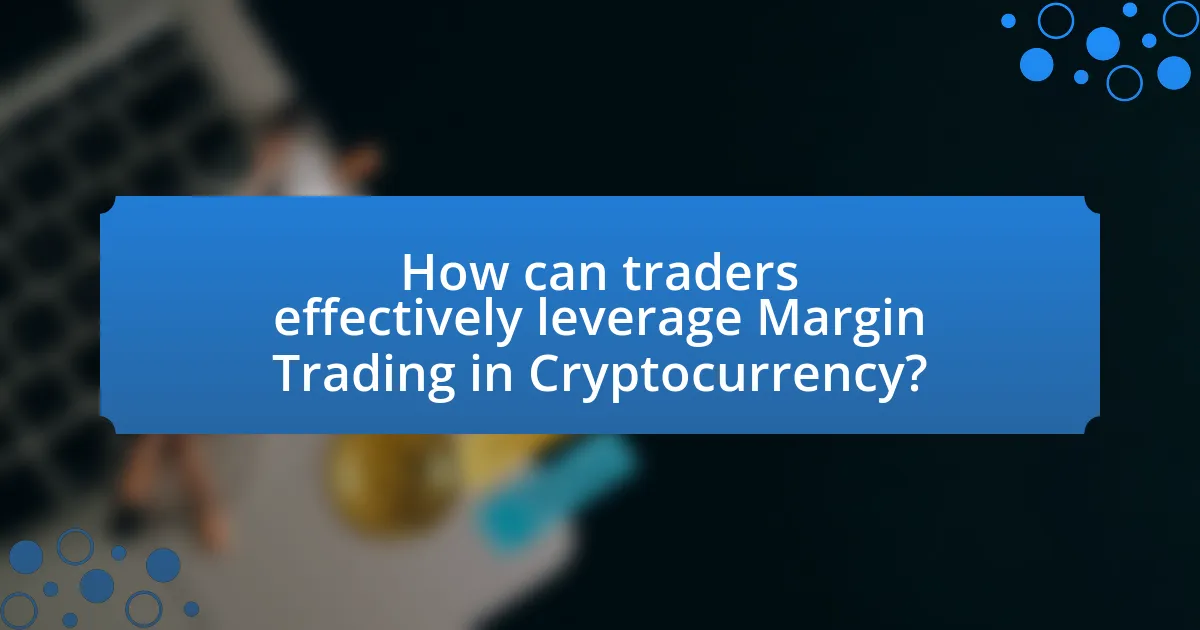
How can traders effectively leverage Margin Trading in Cryptocurrency?
Traders can effectively leverage margin trading in cryptocurrency by using borrowed funds to increase their position size, which amplifies potential profits. This strategy allows traders to control larger amounts of cryptocurrency than they could with their own capital alone. For instance, if a trader uses 10x leverage, they can control $10,000 worth of cryptocurrency with just $1,000 of their own funds. However, this also increases the risk of significant losses, as a small price movement against the position can lead to liquidation. According to a report by the Financial Industry Regulatory Authority (FINRA), margin trading can lead to both higher returns and higher risks, emphasizing the importance of risk management strategies such as setting stop-loss orders and only using a portion of available margin.
What best practices should traders follow when using Margin Trading?
Traders should follow several best practices when using margin trading to mitigate risks and enhance their trading strategies. First, they should only use a small percentage of their total capital for margin trading, typically no more than 10-20%, to limit potential losses. This approach is supported by the principle of risk management, which emphasizes that traders should never risk more than they can afford to lose.
Second, traders must maintain a clear understanding of margin requirements and leverage ratios, as these can significantly impact their positions. For instance, using high leverage can amplify both gains and losses, making it crucial to calculate the appropriate leverage based on market conditions and personal risk tolerance.
Third, implementing stop-loss orders is essential to protect against significant downturns. Research indicates that traders who use stop-loss orders can reduce their losses by up to 30% compared to those who do not.
Lastly, continuous education and staying updated on market trends are vital. According to a study by the CFA Institute, informed traders are more likely to make sound decisions and avoid emotional trading, which can lead to poor outcomes in margin trading scenarios.
How can traders set appropriate leverage levels?
Traders can set appropriate leverage levels by assessing their risk tolerance, understanding market volatility, and analyzing their trading strategy. Risk tolerance determines how much capital a trader is willing to risk on a trade, while market volatility influences the potential for price swings that can impact leveraged positions. For instance, a trader with a high-risk tolerance may opt for higher leverage, such as 10:1, while a conservative trader might choose lower leverage, like 2:1, to mitigate potential losses. Additionally, traders should consider their trading strategy; for example, day traders may use higher leverage due to shorter holding periods, whereas swing traders might prefer lower leverage to withstand market fluctuations.
What tools can assist in managing Margin Trading risks?
Tools that can assist in managing Margin Trading risks include risk management software, stop-loss orders, and margin calculators. Risk management software helps traders analyze their positions and assess potential losses, enabling informed decision-making. Stop-loss orders automatically close positions at predetermined price levels, limiting potential losses. Margin calculators allow traders to determine the appropriate amount of leverage to use based on their account balance and risk tolerance, ensuring they do not overextend their positions. These tools collectively enhance risk management strategies in margin trading.
What common mistakes should be avoided in Margin Trading?
Common mistakes to avoid in margin trading include over-leveraging, failing to set stop-loss orders, and neglecting to conduct thorough market research. Over-leveraging can lead to significant losses, as traders may borrow more than they can afford to repay, resulting in margin calls. According to a study by the Financial Industry Regulatory Authority, many traders underestimate the risks associated with high leverage, which can amplify both gains and losses. Additionally, not setting stop-loss orders can result in holding losing positions for too long, leading to greater financial damage. Lastly, neglecting market research can cause traders to make uninformed decisions, increasing the likelihood of losses.
How can emotional trading affect Margin Trading outcomes?
Emotional trading can significantly impact margin trading outcomes by leading to irrational decision-making and increased risk exposure. When traders allow emotions such as fear or greed to dictate their actions, they may enter or exit positions at suboptimal times, resulting in losses. For instance, a study by the University of California found that emotional decision-making can lead to a 20% decrease in trading performance. This decline occurs because emotional traders often fail to adhere to their trading strategies, increasing the likelihood of margin calls and liquidation of positions.
What are the pitfalls of over-leveraging in trades?
Over-leveraging in trades can lead to significant financial losses and increased risk of liquidation. When traders use excessive leverage, they amplify both potential gains and potential losses, making it easier to lose more than the initial investment. For instance, a 10x leverage means that a 10% decline in the asset’s price results in a total loss of the invested capital. Additionally, over-leveraging can trigger margin calls, forcing traders to deposit more funds or close positions at unfavorable prices, which can further exacerbate losses. Historical data shows that during volatile market conditions, such as the 2018 cryptocurrency crash, many over-leveraged traders faced liquidation, resulting in substantial financial distress.
